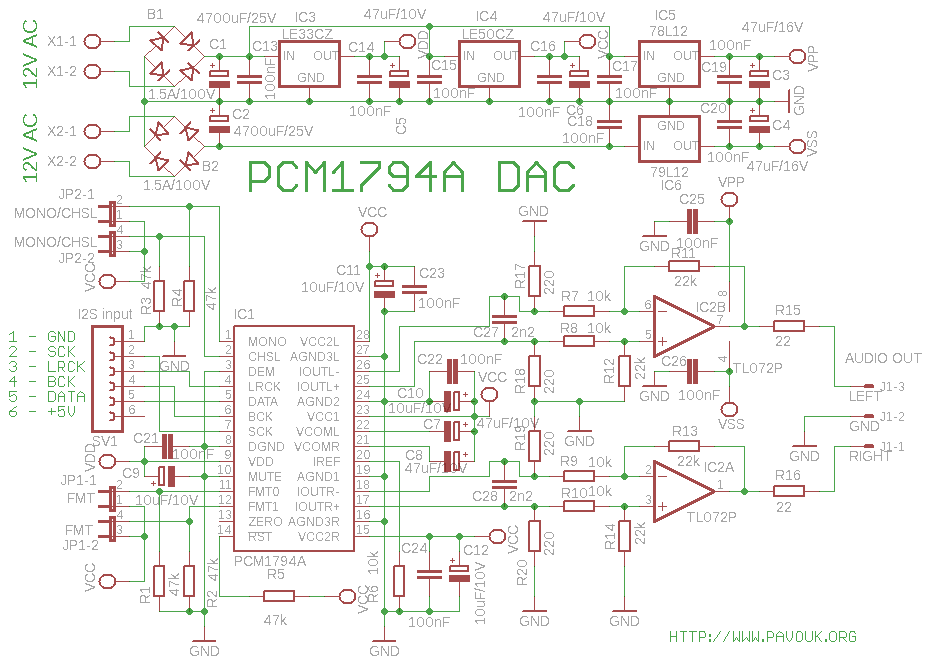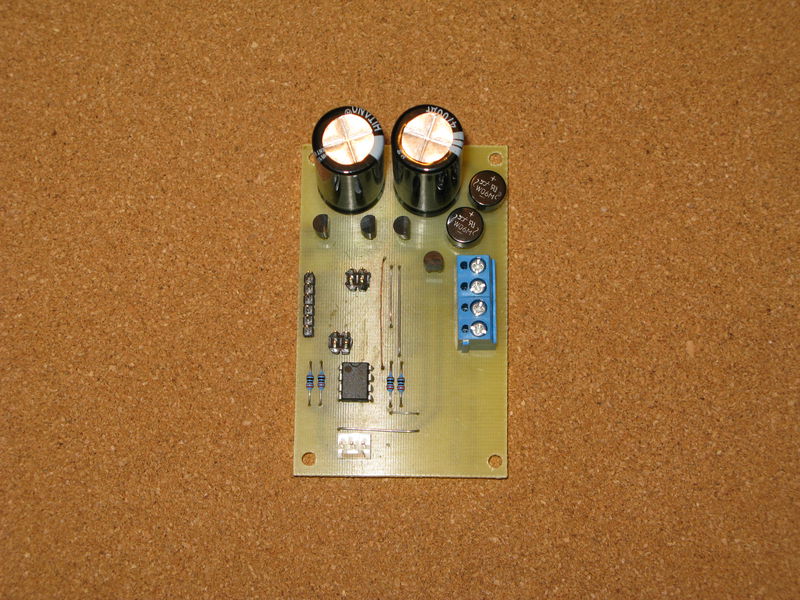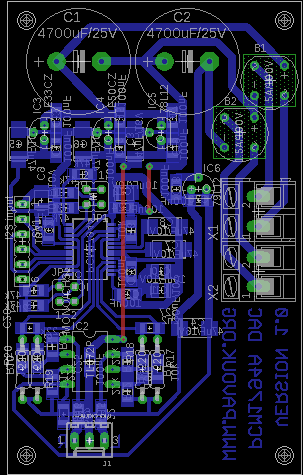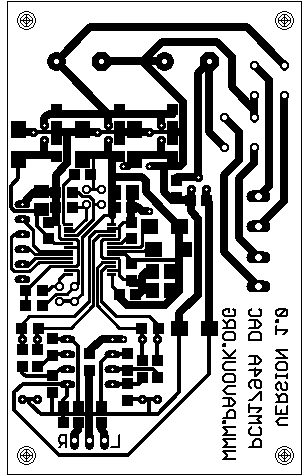| |
This is DAC with integrated circuit PCM1794A. It is one of excellent audio DACs from Burr Brown (Texas Instruments). It has 24-bit resolution, 192kHz sample frequency, 8x oversampling digital filter, differential current output and SNR 127dB.

Circuit description
Circuit includes power supply, DAC and operational amplifier.
For power supply is needed transformer with two individual secondary 12V windings. If you want to supply from transformer S/PDIF decoder and transformer doesn't have third separated winding, we must connect supply input of decoder parallel to winding for positive branch otherwise there will be short circuit. Voltage is rectified by B1 and B2 bridges and goes through filter and decoupling capacitors to low-drop regulators IC3 and IC4 which feeds analog and digital part of DAC. IC5 and IC6 regulates voltage +12V and -12V for operational amplifier. All supply inputs of DAC are properly decoupled with capacitors.
DAC PCM1794A works with data from standard I2S bus. In addition to it use signal SCK - System clock, which needs for proper function and oversampling. Input data format, output type and characterics of digital filter is selected with jumpers. Circuit includes internal reset with external pull-up resistor R5. Output is current differential. For conversion to voltage output I use resistors R17 to R20. They should be high quality carbon resistors. Behind these resistors we can theoretically take out symmetrical output to high impedance input of preamplifier. C27 and C28 are used for limit of high frequencies out of audible sound.
For getting of single-ended output with average value at zero I used low-noise operating amplifier TL072. Gain is about two. I inspired by original circuit because I am not specialist for operating amplifiers. In original circuit are used operating amplifiers for conversion of current to voltage output too. I used only resistors which are better and simpler. In quiet outputs have zero voltage, that theoretically we don't need coupling capacitors. On one output was voltage about 12mV and on another 2.6mV. It can be better by selecting value of resistors.
Schematics diagram
Schematics of DAC with PCM1794A schematics in Eagle 5 format
Assembling
Parts are placed from smaller to bigger. I begin with IC1. Method of his placing is same like on S/PDIF decoder. Next I continued with SMD resistors and capacitors. Next I placed wire connections and components from a top side of board and last connectors.
Component view
Printed circuit board
Printed circuit board is single sided with two wire connections, that it can be easily made in amateur conditions. Ground wires are drawed with accent to separating of digital and analog part. Decoupling capacitors are placed closely to DAC.
PCB of prototype on photos is a little different in these smallness: In schematics is additional pull-up resistor R5 on a reset signal. In datasheet is not discoverable that it must be used. SMD resistors and capacitors with size 0805 was replaced with 1206 size for easier mounting. I was succesful in reducing of wire connections from five to two.
Settings
Circuit is configured with 4 jumpers. When they are not installed, that they are pull-downed to zero with resistors. Setting of audio format is described next in the table. Most frequently I meet with I2S or right-justified 24bit format. If we connect board to our S/PDIF decoder, we must on them set identical data format and frequency of system clock. If we want to play 192kHz samples, we must set system clock maximally to 384 x fs. More informations are in a datasheet.
Audio data format settings
PIN, JUMPER Audio format
MONO, JP2-1 CHSL, JP2-2 FMT1, JP1-2 FMT0, JP1-1 FORMAT STEREO/MONO DF ROLOFF
0 0 0 0 I2S Stereo Sharp
0 0 0 1 Left-justified Stereo Sharp
0 0 1 0 Right-justified 16bit Stereo Sharp
0 0 1 1 Right-justified 24bit Stereo Sharp
0 1 0 0 I2S Stereo Slow
0 1 0 1 Left-justified Stereo Slow
0 1 1 0 Right-justified 16bit Stereo Slow
0 1 1 1 Digital filter bypass Mono -
1 0 0 0 I2S Mono, L-channel Sharp
1 0 0 1 Left-justified Mono, L-channel Sharp
1 0 1 0 Right-justified 16bit Mono, L-channel Sharp
1 0 1 1 Right-justified 24bit Mono, L-channel Sharp
1 1 0 0 I2S Mono, R-channel Sharp
1 1 0 1 Left-justified Mono, R-channel Sharp
1 1 1 0 Right-justified 16bit Mono, R-channel Sharp
1 1 1 1 Right-justified 24bit Mono, R-channel Sharp
Parts
Part list name value and type quantity
R1-R5 47k SMD1206 5x
R6-R10 10k SMD1206 5x
R11-R14 22k SMD 1206 4x
R15-R16 22R SMD 1206 2x
R17-R20 220R 4x
C1-C2 4700uF/25V electrolytic 2x
C3-C8 47uF/10V SMD tantal size C 6x
C9-C12 10uF/10V SMD tantal size B 4x
C13-C26 100nF SMD1206 ceramic 14x
C27-C28 2n2 SMD1206 ceramic 2x
IC1 PCM1794A 1x
IC2 TL072 DIL8 1x
IC3 LE33CZ TO92 1x
IC4 LE50CZ TO92 1x
IC5 78L12 TO92 1x
IC6 79L12 TO92 1x
J1 Molex 3pin 1x
JP1-JP2 JP2Q jumper 2x
B1-B2 Bridge rectifier 1.5A/100V round 2x
SV1 Jumper ribbon 6 pins 1x
X1-X2 Frame terminal AK300/2 2x
Links
* http://www.ti.com/lit/gpn/pcm1794a PCM1794A datasheet
* http://www.audiodesignguide.com/DAC_final/DacFinal.html Final DAC test
* http://www.ezdiyaudio.com/#ezDAC ezDAC with PCM1794/98
Audio DAC with PCM1794A has excellent parameters and sounds great. Traces on a scope looks very good too, but with high frequency 20kHz with sample frequency 44.1kHz we can see in a trace instead of "stairs" some smoothed connection with multiple traces. It is probably normal in a DAC with oversampling. My goal is to have DAC without oversampling which should guarantee high fidelity of playing. Circuit doesn't worked immediately for me. Reason was missing pull-up resistor on RESET signal. It could have insufficient description of reset function and incomplete schematics of circuit in a datasheet or my misunderstanding. For getting better parameters it is possible to try change operational amplifier TL072 with something better. We can completely bypass output amplifier and use symmetrical output before R7 to R10 resistors but only if we have high impedance input. Output from DAC is symmetrical around reference voltage and not around zero. Amplifier has symmetrical power supply and output has average value 0 voltage. We doesn't need to separate them with coupling capacitor. On the output can be a small d.c. voltage about few milivolts which is given by part value tolerance.



|
|
|
| |
Accurate LC Meter
Build your own Accurate LC Meter (Capacitance Inductance Meter) and start making your own coils and inductors. This LC Meter allows to measure incredibly small inductances making it perfect tool for making all types of RF coils and inductors. LC Meter can measure inductances starting from 10nH - 1000nH, 1uH - 1000uH, 1mH - 100mH and capacitances from 0.1pF up to 900nF. The circuit includes an auto ranging as well as reset switch and produces very accurate and stable readings. |
|
PIC Volt Ampere Meter
Volt Ampere Meter measures voltage of 0-70V or 0-500V with 100mV resolution and current consumption 0-10A or more with 10mA resolution. The meter is a perfect addition to any power supply, battery chargers and other electronic projects where voltage and current must be monitored. The meter uses PIC16F876A microcontroller with 16x2 backlighted LCD. |
|
|
|
60MHz Frequency Meter / Counter
Frequency Meter / Counter measures frequency from 10Hz to 60MHz with 10Hz resolution. It is a very useful bench test equipment for testing and finding out the frequency of various devices with unknown frequency such as oscillators, radio receivers, transmitters, function generators, crystals, etc. |
|
1Hz - 2MHz XR2206 Function Generator
1Hz - 2MHz XR2206 Function Generator produces high quality sine, square and triangle waveforms of high-stability and accuracy. The output waveforms can be both amplitude and frequency modulated. Output of 1Hz - 2MHz XR2206 Function Generator can be connected directly to 60MHz Counter for setting precise frequency output. |
|
|
|
BA1404 HI-FI Stereo FM Transmitter
Be "On Air" with your own radio station! BA1404 HI-FI Stereo FM Transmitter broadcasts high quality stereo signal in 88MHz - 108MHz FM band. It can be connected to any type of stereo audio source such as iPod, Computer, Laptop, CD Player, Walkman, Television, Satellite Receiver, Tape Deck or other stereo system to transmit stereo sound with excellent clarity throughout your home, office, yard or camp ground. |
|
USB IO Board
USB IO Board is a tiny spectacular little development board / parallel port replacement featuring PIC18F2455/PIC18F2550 microcontroller. USB IO Board is compatible with Windows / Mac OSX / Linux computers. When attached to Windows IO board will show up as RS232 COM port. You can control 16 individual microcontroller I/O pins by sending simple serial commands. USB IO Board is self-powered by USB port and can provide up to 500mA for electronic projects. USB IO Board is breadboard compatible. |
|
|
|
|
ESR Meter / Capacitance / Inductance / Transistor Tester Kit
ESR Meter kit is an amazing multimeter that measures ESR values, capacitance (100pF - 20,000uF), inductance, resistance (0.1 Ohm - 20 MOhm), tests many different types of transistors such as NPN, PNP, FETs, MOSFETs, Thyristors, SCRs, Triacs and many types of diodes. It also analyzes transistor's characteristics such as voltage and gain. It is an irreplaceable tool for troubleshooting and repairing electronic equipment by determining performance and health of electrolytic capacitors. Unlike other ESR Meters that only measure ESR value this one measures capacitor's ESR value as well as its capacitance all at the same time. |
|
Audiophile Headphone Amplifier Kit
Audiophile headphone amplifier kit includes high quality audio grade components such as Burr Brown OPA2134 opamp, ALPS volume control potentiometer, Ti TLE2426 rail splitter, Ultra-Low ESR 220uF/25V Panasonic FM filtering capacitors, High quality WIMA input and decoupling capacitors and Vishay Dale resistors. 8-DIP machined IC socket allows to swap OPA2134 with many other dual opamp chips such as OPA2132, OPA2227, OPA2228, dual OPA132, OPA627, etc. Headphone amplifier is small enough to fit in Altoids tin box, and thanks to low power consumption may be supplied from a single 9V battery. |
|
|
|
|
|
Arduino Prototype Kit
Arduino Prototype is a spectacular development board fully compatible with Arduino Pro. It's breadboard compatible so it can be plugged into a breadboard for quick prototyping, and it has VCC & GND power pins available on both sides of PCB. It's small, power efficient, yet customizable through onboard 2 x 7 perfboard that can be used for connecting various sensors and connectors. Arduino Prototype uses all standard through-hole components for easy construction, two of which are hidden underneath IC socket. Board features 28-PIN DIP IC socket, user replaceable ATmega328 microcontroller flashed with Arduino bootloader, 16MHz crystal resonator and a reset switch. It has 14 digital input/output pins (0-13) of which 6 can be used as PWM outputs and 6 analog inputs (A0-A5). Arduino sketches are uploaded through any USB-Serial adapter connected to 6-PIN ICSP female header. Board is supplied by 2-5V voltage and may be powered by a battery such as Lithium Ion cell, two AA cells, external power supply or USB power adapter. |
|
200m 4-Channel 433MHz Wireless RF Remote Control
Having the ability to control various appliances inside or outside of your house wirelessly is a huge convenience, and can make your life much easier and fun. RF remote control provides long range of up to 200m / 650ft and can find many uses for controlling different devices, and it works even through the walls. You can control lights, fans, AC system, computer, printer, amplifier, robots, garage door, security systems, motor-driven curtains, motorized window blinds, door locks, sprinklers, motorized projection screens and anything else you can think of. |
|
|
|